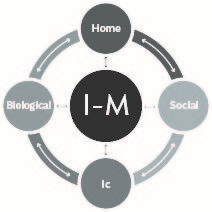Empathy
What Happens When We See Ourselves as Doing the Best We Can?
The I-M Approach changes our perception from less-than to the best-we-can.
Posted February 6, 2017
Last blog I received a comment wondering what is “an I-M thing”? So glad you asked!
The I-M Approach is my premise that we are always doing the best we can at every moment in time with the potential to change in the very next second to another I-M. The definition of an I-M is a current maximum potential. And I am suggesting that all of us are always at an I-M: this is who I am.
Many people see themselves through a lens of “What is wrong with me?” feeling broken and unsure of one’s value in the world. But I believe each of us is reacting and responding the best we can to the influence of the world around us, and the world within us- and that is the crux of The I-M approach.
The Four Domains of the I-M Approach
Who we are is influenced by four domains as illustrated in this picture:

Two of these domains are inside our bodies: our Biological domain of our brain and body, and a domain I call the Ic domain, or how I see myself and how I think other people see me: the domain of Theory of Mind. Two domains are outside our bodies: our Home and Social domains. All four interact fluidly and the result is our I-M, our current maximum potential, doing the best we can at this moment in time with the potential to change in the very next second to another I-M: this is who I am.
Much of medicine has been influenced by the bio-psycho-social model. My I-M Approach extends it by adding Theory of Mind, the fundamental building block of all human interaction. As I said in an earlier blog, we are interested in what other people think or feel: we call this empathy. But we are especially interested in what someone else is thinking or feeling about me. Millions of years ago it was much more important to know if someone was looking at me as their lunch than if they were hungry.
Next blog I will explore the four domains.
It’s an I-M thing.
References
Shrand, J, with Devine, L. (2014) The Fear Reflex. Hazelden Press
Shrand, J, with Devine, L. (2015) Do You Really Get Me? Hazelden Press


